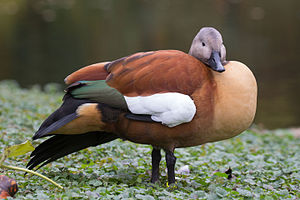Gray-headed Kasarka
| Gray-headed Kasarka | ||||||||||||
|---|---|---|---|---|---|---|---|---|---|---|---|---|

Gray-headed Kasarka ( Tadorna cana , male) |
||||||||||||
| Systematics | ||||||||||||
|
||||||||||||
| Scientific name | ||||||||||||
| Tadorna cana | ||||||||||||
| ( Gmelin , 1789) |
The gray-headed kasarka ( Tadorna cana ) is an African species from the demi-geese subfamily . Like all kasarkas, the gray-headed kasarka also shows features of ducks rooting in the shallow water zone and features of grazing geese in the adjacent pasture areas. It only occurs in the southern end of Africa.
In Central Europe, the gray-headed kasarka can occasionally be observed as so-called captive refugees flying freely. In Switzerland there have also been mixed broods with rust geese naturalized there .
Appearance
Gray-headed Kasarcas have an average body length of 64 centimeters. The difference in plumage is small between the sexes. In males, the sides of the head are consistently gray, while in females they are differently expanded. However, at 1.5 kilograms, the males are a little heavier than the females. These weigh an average of 1.2 kilograms.
The calm dress shows only a few differences to the splendid dress. It is a little darker overall and the cloak plumage has fine, black and gray scribbling. The breast is pale yellow.
The coat plumage of the youth dress is clay yellow to clay brown. The head, on the other hand, is gray-brown, with the base of the beak being slightly lighter. The large elytra are gray, while they are white in the adult birds. Females have white circles under the eyes when they are young.
The male calls deep hou or honk and occasionally a hares hark . Females in between while defending their brood.
Distribution, habitat and way of life
Gray-headed Kasarkas breed in southern Africa. The centers of distribution are Namibia and the Republic of South Africa . During the African winter, a large part of the population moves in a northeastern direction in order to moult there. Around 75 percent of the total population gathers on a few bodies of water during this time. The population is estimated at around 42,000 individuals.
The preferred habitat of the gray-headed casarcas are large, flat lakes and rivers. You also benefit from the reservoirs created in agricultural zones.
The start of breeding depends on the regional rainy season and the food supply in the respective area. The gray-headed Kasarkas occupy large breeding areas and defend them aggressively. The brood takes place in burrows. They often use the aardvark burrows . These are often far from the nearest body of water. A clutch usually contains between ten and fourteen eggs. The incubation period is 30 days. The young birds are sexually mature from the age of 2. After rearing the young, gray-headed casarcas form loose swarms.
Gray-headed Kasarcas are predominantly plant-based. They prefer to eat tender leaves, flower heads and seeds and sometimes also ingest large amounts of algae. Insect larvae and crustaceans are also eaten.
Attitude in Europe
Gray-headed casarcas are shown in many zoos today. Until 1940 they were only very rarely imported into Europe. Today's European enclosure population largely descends from imported animals from the 1960s. Gray-headed Kasarkas are easy to breed and are considered the most robust species within the genus of the Kasarkas . However, they are also very aggressive, so that they usually have to be kept in individual enclosures.
Individual references and further literature
- ↑ Bauer et al., P. 79
- ↑ Kolbe, p. 137
- ↑ Kolbe, p. 138
- ↑ Bauer et al., P. 79
- ↑ Kolbe, p. 138
- ↑ Kolbe, p. 138
literature
- Hans-Günther Bauer, Einhard Bezzel and Wolfgang Fiedler (eds.): The compendium of birds in Central Europe: Everything about biology, endangerment and protection. Volume 1: Nonpasseriformes - non-sparrow birds. Aula-Verlag Wiebelsheim, Wiesbaden 2005, ISBN 3-89104-647-2 .
- T. Bartlett, Ducks And Geese - A Guide To Management , The Crowood Press, 2002, ISBN 1-85223-650-7
- Hartmut Kolbe; Die Entenvögel der Welt , Ulmer Verlag 1999, ISBN 3-8001-7442-1
Web links
- Tadorna cana inthe IUCN 2013 Red List of Threatened Species . Listed by: BirdLife International, 2012. Retrieved October 13, 2013.

